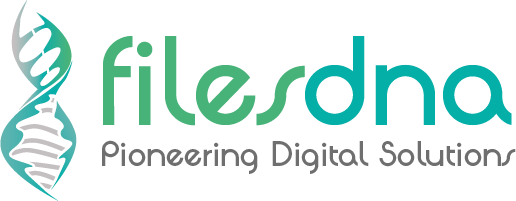The transition to a digital world has the ability to make e-signing documents a very safe process or a vulnerable process – depending on the technologies that are used. Here at FilesDNA, we use multiple security levels in our e-signature process to verify users’ identification before signing. By partnering with us, your organization can ensure that the person who is supposed to be signing the document is the only one who signs, and that their signature has not been forged.
Digital Signature and e-signature Explained
When you have an electronic document that requires a signature, there are going to be two types of signatures on it: digital and electronic. It may sound like these terms are interchangeable, but they are quite different and it’s important to understand the distinction.
- A digital signature refers to the unique identity of the document itself. Encryption services (like blockchain) are used to define the hash value on the document and signal is and when there is a change. Users will know if there has been unverified activity if the hash values of their documents don’t match up.
- An electronic signature, also known as an “e-signature” is the electronically written signature that is places on a document to symbolize agreement and a legally bound relation between one or more parties. When an e-signature is placed on a document, that signature is also encrypted for protection. Thus, a unique hash value is created for the e-signature so it can be verified by the individual parties.
FilesDNA protects both digital signatures and electronic signatures. Here is how we protect e-signatures with verification processes before signing:
How to Verify e-signature with FilesDNA
There are many ways to verify e-signatures and each method can be stacked on top of the last to create multiple layers of security. Essentially these verification processes “unlock” a document so the intended user can sign their name.
FilesDNA uses the following methods of e-signature verification to protect all signing parties involved in a transaction from fraudulent activity.
- Smart Signature Pad – An electronic “pen” and “pad” with artificial intelligence and machine learning technologies built in to learn unique signature parameters and reject fraudulent ones.
- Liveness Detection – Our technologies can detect a live person from a bot through the use of biometrics.
- Voice Recognition System – We can capture the unique parameter of a person’s voice to protect their identity and e-signature.
- ID and Passport Verification System – Scan and save your official government documents to prove your identity and protect it from being stolen.
- Fingerprint – Sign documents with your unique fingerprint.
- Email and Mobile Number – Verify your identity by communicating with our system through email and/or mobile phone.
- Near Field Communication (NFC) Tag – Each verified user will have their own NFC Tag that is linked to their account. They can use the NFC when they open/edit the document or when they create/add their signature to any document. The NFC adds another security layer to two-factor authentication processes.
FilesDNA believes that there is nothing more precious than your unique identity. We help users and organizations protect their identities by using multi-step, layered verification processes that cannot be intercepted. If this sounds like a solution you’re ready to try, contact FilesDNA today.




